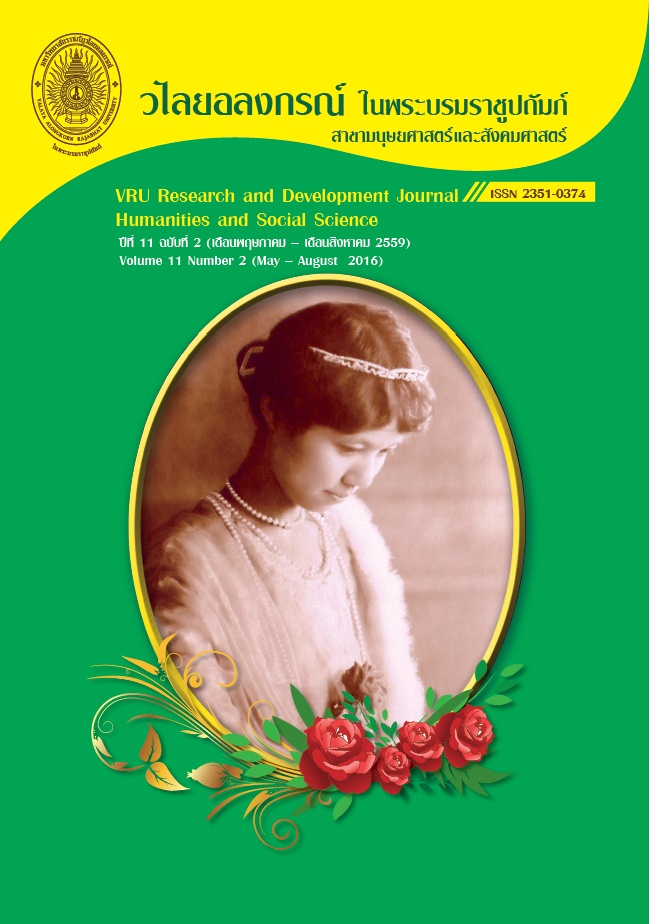กลยุทธ์การตลาดตามการดำเนินชีวิตที่ส่งผลต่อภาพลักษณ์ตราสินค้าในสายตาผู้บริโภค
Main Article Content
Abstract
การวิจัยนี้มีวัตถุประสงค์เพื่อสำรวจถึงผลกระทบของกลยุทธ์การตลาดตามการดำเนินชีวิตที่มีต่อภาพลักษณ์ตราสินค้าในสายตาผู้บริโภค โดยใช้การสุ่มตัวอย่างแบบเจาะจงจากกลุ่มผู้บริโภคเครื่องดื่ม X จำนวน 800 คน โดยแบ่งเป็นชาวไทย 400 คนและชาวต่างชาติ 400 คน ซึ่งสถิติที่ใช้ คือ ค่าร้อยละ ค่าเฉลี่ย ค่าเบี่ยงเบนมาตรฐานและการวิเคราะห์ความถดถอยเชิงพหุคูณ โดยผลการวิจัยพบว่าผู้ตอบแบบสอบถามส่วนใหญ่เป็นเพศชาย ที่มีอายุเฉลี่ย 29 ปี มีสถานะโสด และส่วนใหญ่มีการศึกษาในระดับปริญญาตรีที่มีรายได้เฉลี่ยต่อเดือน 15,001-20,000 บาทและประกอบอาชีพพนักงานบริษัท ซึ่งมีพฤติกรรมการบริโภคเครื่องดื่ม X ในช่วงเวลา 10.00 น. - 13.59 น. เพื่อเป็นการคลายความเหนื่อยล้าและบริโภคมากกว่า 12 ครั้งต่อเดือน โดยส่วนใหญ่ได้รับข่าวสารเกี่ยวกับเครื่องดื่ม X จากสื่อออนไลน์ โดยเป็นการตัดสินใจซื้อด้วยตนเอง และผลการทดสอบสมมุติฐานพบว่ากลยุทธ์การตลาดตามการดำเนินชีวิตมีอิทธิพลทางบวกต่อภาพลักษณ์ตราสินค้าในสายตาผู้บริโภค และเมื่อพิจารณารายปัจจัยย่อยของกลยุทธ์การตลาดตามการดำเนินชีวิตแล้ว พบว่าปัจจัยกลยุทธ์การตลาดตามความคิดเห็นส่งผลต่อภาพลักษณ์ตราสินค้าในสายตาผู้บริโภคมากที่สุด รองลงมาได้แก่ กลยุทธ์การตลาดตามกิจกรรมและกลยุทธ์การตลาดตามความสนใจ ตามลำดับ
The objective of this research is to investigate the effect of lifestyle marketing strategy on consumer-based brand image. Sample size of 800 respondents composing of 400 Thai and 400 foreign consumers ofbeverage brand X were drawn using purposive sampling technique. Statistical analysis used for this research includes percentage, mean, standard deviation, and multiple regression. Most of the respondents are males, aged on an average of 29 years old, singles, bachelor’s degree holders, private company employees with an average monthly income between 15,001-20,000 baht. Consumers usually drink beverage brand X between 10.00 a.m. -13.59 p.m. to relax. Most of the consumers drink more than 12 times a month and they usually receive information about beverage brand X through online media. Consumers often make their purchase decisionsof beverage brand X by themselves. According to hypothesis testing, it was found that lifestyle marketing strategy has a positive effect on consumer-based brand image. In addition, the results show that opinion component of lifestyle marketing strategy influences consumer-based brand image the most, followed by activity- and interest-based lifestyle marketing strategy, respectively.
Article Details
ลิขสิทธิ์บทความวิจัยที่ได้รับการตีพิมพ์เผยแพร่ในวารสารมนุษยศาสตร์และสังคมศาสตร์ วไลยอลงกรณ์ ในพระบรมราชูปถัมภ์ ถือเป็นกรรมสิทธิ์ของคณะมนุษยศาสตร์และสังคมศาสตร์ มหาวิทยาลัยราชภัฏวไลยอลงกรณ์ ในพระบรมราชูปถัมภ์ ห้ามนำข้อความทั้งหมดหรือบางส่วนไปพิมพ์ซ้ำ เว้นแต่จะได้รับอนุญาตจากมหาวิทยาลัยเป็นลายลักษณ์อักษร
ความรับผิดชอบ เนื้อหาต้นฉบับที่ปรากฏในวารสารมนุษยศาสตร์และสังคมศาสตร์ วไลยอลงกรณ์ ในพระบรมราชูปถัมภ์ เป็นความรับผิดชอบของผู้นิพนธ์บทความหรือผู้เขียนเอง ทั้งนี้ไม่รวมความผิดพลาดอันเกิดจากเทคนิคการพิมพ์
References
กรมการปกครอง กระทรวงมหาดไทย. (2557). ข้อมูลประชากรศาสตร์ในเขตกรุงเทพมหานคร. 1มีนาคม 2558. http://stat.dopa.go.th/stat/statnew/upstat_age.php
วันธิดา จันทกิจ. (2547). อิทธิพลของการเป็นผู้สนับสนุนกิจกรรมต่อภาพลักษณ์ตราสินค้า. วิทยานิพนธ์ ปริญญามหาบัณฑิต, จุฬาลงกรณ์มหาวิทยาลัย.
ปราโมทย์ ศักดิ์ศรีสง่ากุล. (2547). การศึกษาโครงสร้างตลาดและกลยุทธ์ทางการตลาดของเครื่องดื่มชูกำลัง : กรณี ศึกษาบริษัท เครื่องดื่มกระทิงแดง จำกัด. วิทยานิพนธ์ ปริญญามหาบัณฑิต,มหาวิทยาลัยเกษตรศาสตร์.
ปัทมา ขอบจิต. (2545). การดื่มเครื่องดื่มชูกำลังในคนงานก่อสร้างชาย. วิทยานิพนธ์ ปริญญามหาบัณฑิต,มหาวิทยาลัยมหิดล.
มติชน. (2556). พลิกวิกฤติให้เป็นโอกาสกับตลาดกระทิงแดง. 24 มีนาคม 2558. https://humanrevod.wordpress.com/tag/marketing/
สุรีย์พร พงษ์พินิจ. (2548). แนวทางการสร้างตราสินค้าสำหรับสำนักงานสถาปนิก. วิทยานิพนธ์ ปริญญามหาบัณฑิต, จุฬาลงกรณ์มหาวิทยาลัย.
Antonides, G. and Van Raaij, W.F. (1998). Consumer Behavior : An European Perpective. Chicheter: John Wiley and Sons.
Ghodeswar, B. M. (2008). Building brand identity in competitive markets: a conceptual model. Journal of Product & Brand Management, 17 (1), 4 – 12.
Macmillan, P. (2013). Lifestyle Brands: A Guide to Aspirational Marketing.Journal of Consumer Marketing, 31 (4), 321-332.
Ottenbacher, M. C. & Harrington, R. J. (2010). Strategies for achieving success for innovative versus incremental new services. Journal of Services Marketing, 24 (1), 3-15.
O’Dwyer, M., Gilmore, A. & Carson, D. (2009). Innovative marketing in SMEs. European Journal of Marketing, 43 (½), 46-61.
Positioning Magazine. (2009). กระทิงแดงเจาะเวลาหาวัยรุ่น. 27 กุมภาพันธ์ 2558, http://www.positioningmag.com/content/กระทิงแดงเจาะเวลาหาวัยรุ่น
Rubin, A. (1986). Marketing communications. New Jersey: Prentice Hall.
Yamane, T. (1967). Taro Statistics : An Introductory Analysis. New York: Harper & row.

